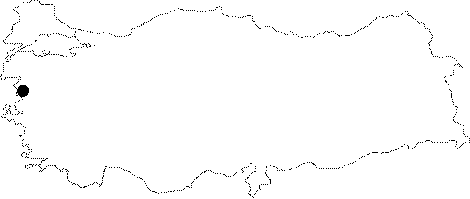|
©The Archaeological Settlements of Turkey - TAY Project
|
|
|
|
|
|
Yeni Yeldegirmeni Tepe |
|
|
For site maps and drawings please click on the picture...  |
For photographs please click on the photo...  |
|
Type:
|
Mound |
|
Altitude:
|
30 m |
|
Region:
|
Aegean |
|
Province:
|
Balikesir |
|
District:
|
Ayvalik |
|
Village:
|
Altinova |
|
Investigation Method:
|
Excavation |
|
Period:
|
EBA II |
|
|
|
 |
|
| Location: It is located about 2.5 km from the Aegean Sea; 1.5 km west of Altinova; south of the district of Ayvalik in the province of Balikesir. |
| Geography and Environment: It lies in the alluvial plain formed by Madra stream. During the geomorphologic researches conducted by I. Kayanit was determined that the Aegean Sea was located nearby the mound. The mound is partly destructed; there is a water tank and a building atop. There are also traces of destruction on the southern and western sections. According to the distribution of the ceramics; the settlement measures 100x90 m. |
| History: |
| Research and Excavation: It was discovered during the Madra Brook survey carried out by K. Lambrianidis in 1991. When it was discovered; it was first thought as Kaymaktepe which was excavated by K. Kökten in 1948. Later; this interpretation was given up. The mound was excavated by K. Lambrianidis and N. Spencer in 1997. It takes place in the registered archaeological sites list prepared by Ministry of Culture and Tourism. |
| Stratigraphy: Three trenches were opened. One of them is stepped; opened in order to identify the stratification. A depth of ca. 2 m was reached at this trench. In the upper level; there are graves reported to belonging to Ottoman Period; and under this level EBA remains were brought to light. The bedrock was not reached. |
| Small Finds: Architecture: The stepped trench yielded a 1.5 m thick wall built of big stones belonging to EBA. A tiny stone wall was observed over this wall; which probably belongs to a later period. Under the big wall; another wall of mudbrick was uncovered accompanied with burnt floors. The mudbrick wall continues under this layer. In the inner part of the wall; there is floor of compressed clay. And; another wall cut across this wall vertically and there is a hearth where these two walls join. Two more trenchs were opened. One of them again yielded graves of Ottoman Period. Under these graves; walls belonging to an elaborately built structure were uncovered. In the corner; there is a stone hearth. The third trench yielded a big stone wall dating to EBA built slanted and smaller walls in parallel to this wall. Pottery: The surface color of EBA pottery is grey; beige; reddish brown; red and black; and very well burnished. A limited number of red thin washed; red washed sherds was recovered. Forms of bowls with unrolled rims and pierced lugs attached horizontally to the rims are typical. Also found are bowls with inner-thickened lips; footed bowls; necked jars and anthropomorphic vessels of Troy II. Other: During the opening of the stepped trench; two flat idols; one in marble; were collected from the surface. Also; both the excavation and surface collection yielded polished stone axe and spindle whorls. |
| Remains: |
| Interpretation and Dating: K. Lambrianidis and N. Spencer date Yeni Yeldegirmeni Tepe to Troy I-II (EBA II); black layer of Poliochni and Termi I-II. |